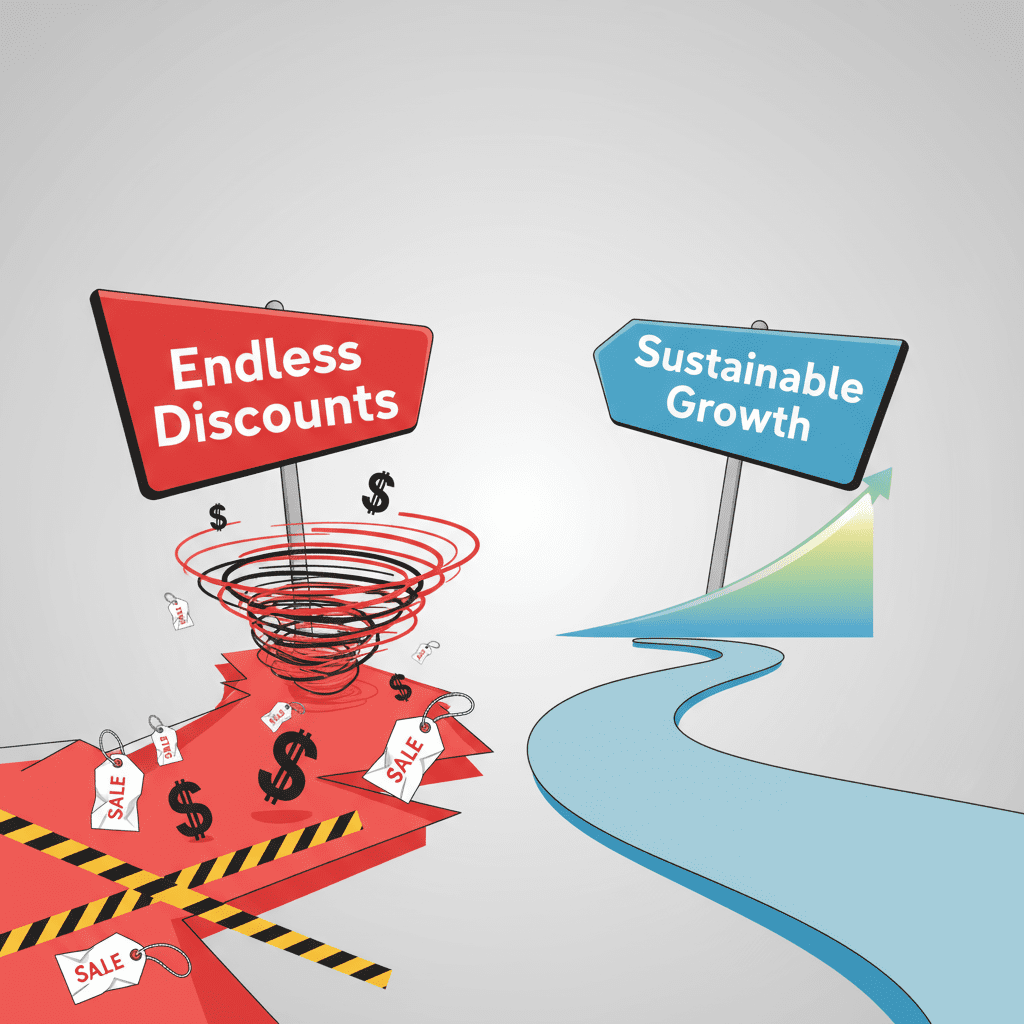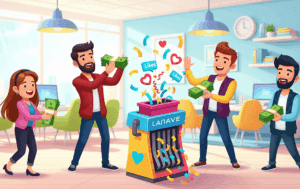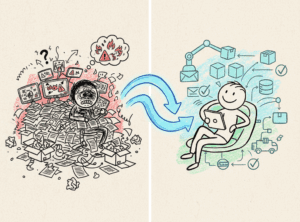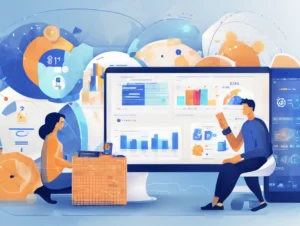Promotions are one of the most tempting tools in an e‑commerce merchant’s toolbox. Run a sale, and boom—traffic spikes, carts fill, and revenue shoots up. It feels great. The boardroom gets excited, the charts go up, and suddenly everyone’s talking about what promo to run next.
But here’s the thing – promos are like a drug. They give you a high today, but tomorrow you crash. And if you’re not careful, you’ll find yourself hooked—unable to sell without them, training your customers to only buy on discount, and slowly bleeding away your margins.
I’ve seen this play out many times in my career, with clients, employers, colleagues, and friends. I’ve seen it happen to both global brands and with smaller retailers. It’s a cycle that’s hard to break, but it can be broken. You just need to understand the mechanics and put some discipline around how you use promotions.
In this post, I’ll walk through why promos feel so good, why they’re dangerous, and what happens when you get addicted. I’ll include a real story from my own career about breaking the cycle, and provide some practical guardrails you can use to keep promos working for you instead of the other way around.
Why Promos Feel So Good (At First)
Promotions work because they trigger urgency and scarcity in customer psychology. Shoppers love a deal, and the fear of missing out (FOMO) pushes them to act quickly. When you drop 20%, 30%, or 50% off, you’re not just lowering price —you’re creating a short‑term rush of attention. (By the way, there’s other way to create FOMO without discounting – but that’s for another post).
From a business perspective, the immediate benefits are obvious:
- Traffic spikes: A promo can bring new eyeballs in quickly.
- Conversion rates jump: Even hesitant shoppers who’ve been browsing may finally hit “buy.”
- Revenue looks great: For that week or month, your numbers are up.
But here’s the problem- you’re not creating new demand out of thin air. You’re borrowing against future sales. That customer who bought today at 30% off might have bought next week at full price. Instead of pulling in new revenue, you’ve simply shifted it forward—and at a lower margin.
It’s like putting sales on a credit card. You get the hit today, but the bill comes due tomorrow.
The Dark Side: When Discounting Becomes Addiction
The real danger is when promotions stop being an occasional tactic and start becoming the norm. Here’s what happens:
-
- Customers get trained. Once buyers know you run sales every other week, why would they pay full price? They’ll just wait.
- Margins erode. You may be selling more units, but you’re making less per unit. Your profit shrinks even as your workload grows.
- Budgets get distorted. If your forecasts assume constant promo sales, you’re stuck increasing discounts just to hit targets.
- Competitors catch on. If everyone is discounting, your “special” promo is now just table stakes.
Over time, this creates a treadmill effect – you’re running faster and faster (more promos, deeper discounts) but not actually getting ahead. Eventually, you hit the wall—you can’t discount further without losing money.
A Story from the Trenches – Breaking Free (and Relapsing)
At one company I worked with, we realized we’d fallen deep into the promo trap. Every month was built around discounts. Sales were strong, but profitability was weak, and our brand was being devalued. We made a tough decision – we were going to get clean.
It was not easy. Like any addiction, withdrawal hurts. Traffic dipped, sales dipped, and the pressure from executives was intense. But we held the line. Slowly, over the course of a year, customers adjusted. We rebuilt our positioning around value, not discounts. And it worked—profitability improved, and the business was healthier.
Then came the relapse.
We hired a new director of digital marketing. His solution to every traffic issue? More promos. Within months, the cycle was back, and with a vengeance. Sales spiked short‑term, but because we were borrowing against the future, the numbers couldn’t sustain. After a brief high, conversion rates collapsed, margins tanked, and the business swung from profitable to losing money. In the last month of the year, he ended losing half of the profit we had made so far that year. It was a painful reminder – once you’re clean, you need discipline to stay that way.
The Exception: When Promos Make Sense
Now, I’m not saying you should never run promos. That would be unrealistic—and frankly, unwise. There are times when discounting is not just acceptable but expected.
Seasonal Events and Industry Norms
Black Friday, Boxing Day, Cyber Monday, back‑to‑school—these are cultural shopping events. If you sit them out, you’re not signalling “we’re premium.” You’re signalling “we forgot to show up.” I once managed two similar brands across a Black Friday weekend. One ran a promo and sold ten times their average weekend volume. The other decided not to discount, worried about upsetting retail partners. Their sales dropped to a quarter of normal—and their retailers ran discounts on their products anyway. Ouch.
Tactical Levers
Promos can also be used sparingly as a lever when you need to correct a dip—say, a slow month or unexpected inventory overhang. The key is to note when you do this and not build it into your baseline. Think of it like taking painkillers after an injury: they can help in the moment, but you don’t want to live on them.
Guardrails to Keep Promos Healthy
So how do you keep discounts working for you instead of against you? Here are some practical steps:
1. Set Promo Boundaries
Decide in advance which events you’ll run promos for (e.g., Black Friday, end‑of‑season clearance) and stick to them. This prevents the slippery slope of “just one more sale.” We had six key times throughout the year that we referred to as “The Big 6”, and adhered to those, and only those, for any sitewide sale.
2. Track True Impact
Don’t just look at revenue spikes. Measure profitability, customer lifetime value (CLV), and repeat purchase rates. If promo customers don’t come back at full price, you’re not building a healthy base.
3. Avoid Training Customers
Be careful about consistency. If you run a “25% off every other Friday” deal, you’ve essentially lowered your baseline price. Mix up timing, mechanics, and offers so customers can’t predict discounts.
4. Focus on Value Beyond Price
Invest in product quality, customer experience, and unique value propositions. If the only reason people buy from you is price, you’re in a race to the bottom.
5. Use Promos as a Pressure Valve
Treat discounts like a lever to pull when needed—not as the main engine of growth. If traffic dips, use a promo to spark activity, but note it in your reporting and don’t build future budgets expecting it to repeat.
Lessons Learned from 30+ Years in Digital
Looking back over three decades, I’ve seen discount culture rise, evolve, and in many cases, implode. In the early days, promos were rare and exciting. Then they became constant—“flash sales,” “friends and family events,” “VIP discounts” every week. Now, customers almost expect to find a code before they hit checkout.
The brands that thrive are the ones that learn to balance. They know when to discount (strategically, tactically) and when to hold firm. They use promotions as a tool, not a crutch. And they build long‑term customer relationships based on trust, quality, and service—so that when they do run a sale, it feels special again.
Final Thought: Don’t Let Promos Run You
Promotions are powerful, but like any powerful tool, they can do more harm than good if misused. Think of them as a lever, not a lifestyle. Plan them, measure them, and use them with discipline. Don’t get caught in the cycle of borrowing against tomorrow’s sales just to make today’s numbers look good.
And if you find yourself already hooked, don’t panic. Like any addiction, you can get clean—with patience, discipline, and a clear strategy. It won’t be easy, but the payoff is a healthier, more profitable, and more sustainable business.
What’s your experience with promos? Have you ever tried to go “cold turkey” on discounts, or do you see them as a necessary part of your business model? Share your thoughts in the comments—I’d love to hear how others are navigating this tricky balance.





